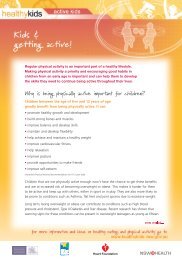I Move We Move - Good For Kids - NSW Government
I Move We Move - Good For Kids - NSW Government
I Move We Move - Good For Kids - NSW Government
Create successful ePaper yourself
Turn your PDF publications into a flip-book with our unique Google optimized e-Paper software.
Adult guided fundamental movement skills learning experiences for toddlers and<br />
preschoolers<br />
Similar to babies, adult guided fundamental movement skills learning experiences for toddlers<br />
mostly involve one on one interaction with adults. <strong>For</strong> older toddlers this could occur in groups<br />
and for preschoolers, adult guided fundamental movement skills learning experiences could involve<br />
participation in large groups of children, small groups, pairs or as individuals.<br />
Frequency and Duration<br />
Programming adult guided fundamental movement skills experiences<br />
into each day will enable all children attending the service to have the<br />
opportunity to participate several times a week. When deciding on<br />
learning experiences consider how much physical activity time your<br />
service is aiming for each day and ensure there is an appropriate<br />
balance of adult guided fundamental movement skills learning<br />
experiences as well as free active play.<br />
Verbal prompts<br />
Providing appropriate verbal prompts and feedback will enhance children's<br />
experience of learning fundamental movement skills. Providing feedback<br />
to children on what they need to do to improve their skills greatly enhances their<br />
learning. Try to ‘sandwich’ corrective feedback with two positive comments e.g.<br />
“That was a great effort. This time let’s put the other foot forward. Keep trying!” 23<br />
I <strong>Move</strong> <strong>We</strong> <strong>Move</strong>, The Guide Edition 1 August 2009<br />
Did you know?<br />
There is also a specific type of verbal prompt that explains how to perform a skill, known as a<br />
teaching cue. Teaching cues can be a very powerful strategy to help young children understand<br />
how to perform a skill. They should use simple words and/or imagery to describe a skill component<br />
and act as the stimulus for skill execution. <strong>For</strong> any of the skills you can demonstrate the movement<br />
and ask children to talk about what they think it looks like. Children can then come up with the<br />
cues for these movements themselves 23 .<br />
See Table 1 (page 5.7) for some examples of teaching cues that use imagery and<br />
simple words.<br />
AREA HEALTH SERVICE<br />
5.6<br />
Preschool aged children<br />
need a balance of adult<br />
guided activities and free<br />
active play every day.




